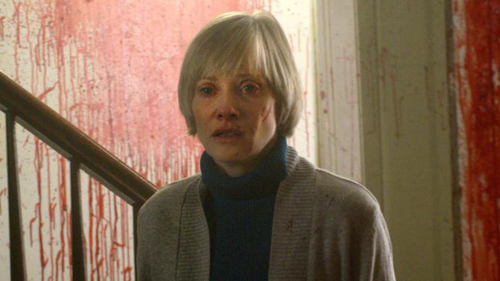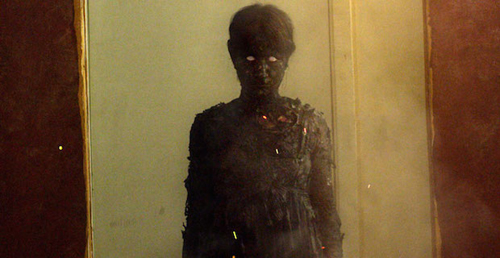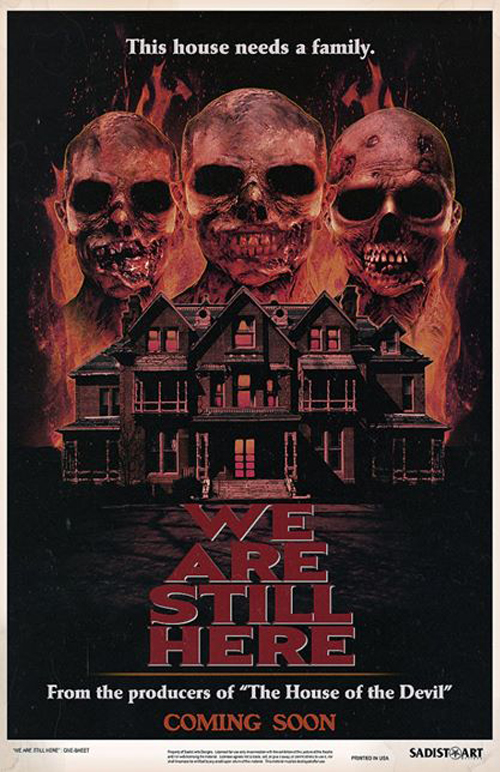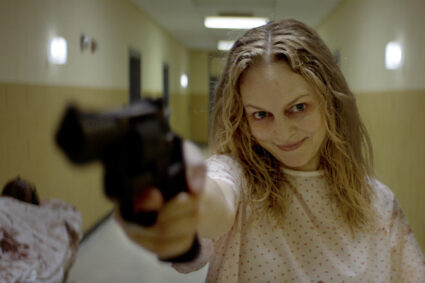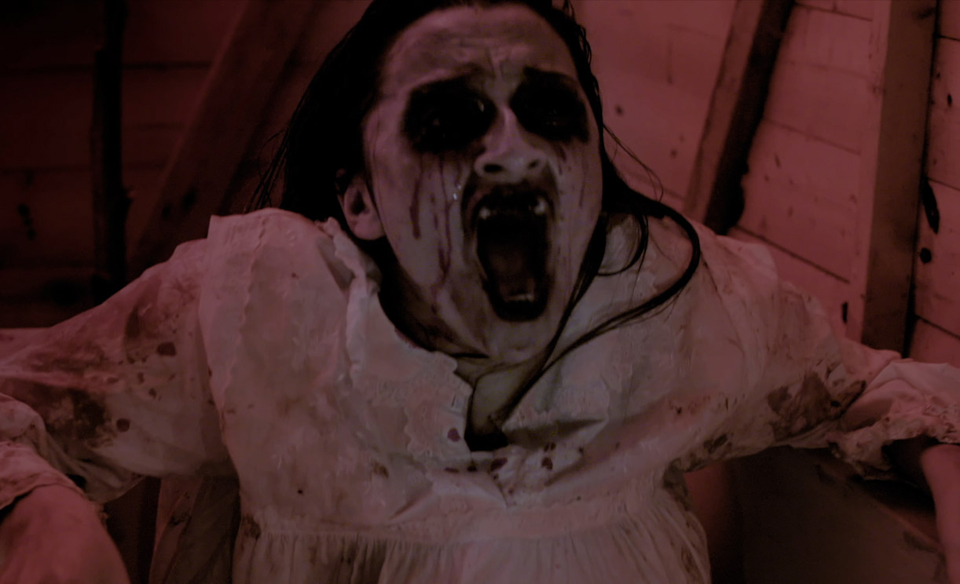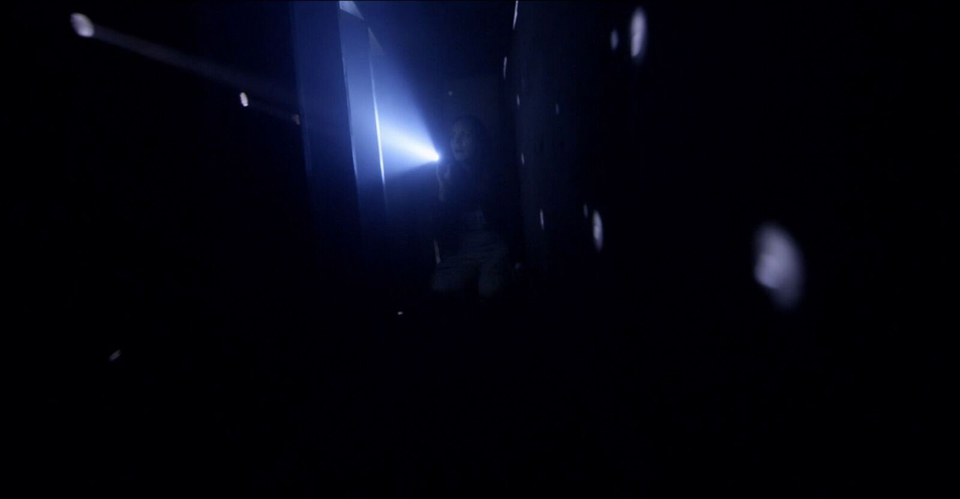
It’s billed as an homage to Lucio Fulci, and at times, it feels superior. We Are Still Here, which is Ted Geoghegan’s debut full-length film as a director, touches the Fulci basics: it’s got gore, an isolated house in New England, a troubled family dealing with grief, a clairvoyant, a vaguely Lovecraftian plot, and a town with a sordid past. But as much as We Are Still Here is Fulci worship, it is also its own film.
While Fulci mastered blood-soaked exploitation, Geoghegan’s film is a quiet, slow-building indie chiller that saves all its gristle for the final twenty minutes. Nothing highlights this fact more than the differences in music. At their best, Fulci’s films disgust audiences while at the same time giving them a tune to remember. This is why we know the name Fabio Frizzi—the king of the sweepingly epic synthesizer. We Are Still Here, on the other hand, gently layers minimalist keys and splashes of reverb underneath scenes that are almost always tense, but rarely over-the-top. In a weird example of unintentional irony, the score to We Are Still Here, which features a cast of crispy ghosts who were once burned alive by an Aylesbury mob, is reminiscent of Burzum’s twenty-five minute track “Rundtgåing av den transcendentale egenhetens støtte” off of 1996’s Filosofem. Varg and burning go together, once again.
The biggest difference between Fulci and Geoghegan remains the screenplay. Fulci had nothing but contempt for it and, as such, his films display abject torture sequences like loving money-shots. Comprehensible plot is always secondary in the Fulci canon. Geoghegan, who penned the script to We Are Still Here, does not share Fulci’s animus, and because of this We Are Still Here finds a nice balance between intelligible plot and not giving too much away. Suffice it to say that We Are Still Here is only a haunted house movie in masquerade; the real monster in the basement is something more than a mere ghost.
The principal players in We Are Still Here are the Sacchetti family. Named after Fulci’s longtime writing partner and lifelong enemy Dardano Sacchetti, the Sacchettis are two grieving parents who have left “the city” (presumably New York) for the quiet of rural New England in the dead of winter. Anne (played by the wonderful Barbara Crampton, who is most famous for almost receiving severed head cunnilingus in Re-Animator) is having a difficult time dealing with the recent death of her son Bobby. She’s even convinced herself, and to a lesser extent her husband Paul (played by Andrew Sensenig), that Bobby has traveled with them and is now a friendly ghost in their new house.
Well, leave it to the neighbors to break that illusion. One night, after things have already started getting weird, the Sacchettis meet Dave McCabe and his wife Cat (played by Monte Markham and Connie Neer respectively). Even before finishing his first whisky, Dave McCabe spooks the entire household by recounting the tragic fate of the Dagmar family. Well over a hundred years prior, in 1859 (the movie is supposedly set in 1979), the Dagmars ran the house as a funeral parlor according to the town’s wishes. The town had even built the house for the family, but soon turned against the Dagmars when it was revealed that the family patriarch was selling the corpses entrusted to his care to a medical school and even Chinese restaurants in Boston. After that, the town ran Dagmar and his family out, which eventually led Father Dagmar to an early grave due to suicidal drinking. According to McCabe, it’s more than likely that the Dagmars still see the Sacchetti home as their own property.
With a cheery introduction like that it’s hard to imagine an even worse exit, and yet it happens. Dave and Cat leave in a hurry, but not before Cat clandestinely slips a piece of paper into Paul’s palm. It basically says: “Get Out!”
Of course, the Sacchettis stay and even invite over some friends. In order to make contact with the beyond, Anne calls up her city friends and supernaturalist practitioners May (played by Lisa Marie) and Jacob (played by Larry Fessenden). In turn, May and Jacob bring along their son Harry (played Michael Patrick Nicholson) and his girlfriend (played by Kelsea Dakota). Sadly, the younger couple isn’t long for this world and end up as the film’s first casualties. May and Jacob, however, stay a little longer and are the first to hit upon the fact that not only are the smoke-ghost Dagmars still kicking around, but that a greater darkness rings the entire house. Things really come to a head when, during an unsanctioned séance, Jacob gets possessed by the very angry Daddy Dagmar and starts spouting off about the wickedness of the town. Jacob-cum-Dagmar calls McCabe a liar, and We Are Still Here transitions from an old dark house story to an evil little town story.
This narrative switcheroo is well-played and enhances the story rather than hampers it. Geoghegan and cinematographer Karim Hussain’s decision to include a lot of wide shots depicting the snowbound scenery also adds to the film’s creeping sense of dread and isolation. And to top it all off, the town, which the end credits call Aylesbury like the Aylesbury Pike in Lovecraft’s “The Dunwich Horror,” is a believably bad place with a panicked populace frightened by their own history just like the folks of Arkham in Roger Corman’s 1963 Lovecraft masterpiece The Haunted Palace.
Where We Are Still Here falters is over the issue of acting. While the ending and some points of the characterization of Anne bear too many close resemblances to last year’s critical darling The Babadook, it is the acting—the often stiff, vacant acting—that does the most damage to We Are Still Here. The most egregious offender is Lisa Marie, the former model and lovesqueeze of Tim Burton whose collagen upper lip almost distracts from her monotone delivery. Sensenig is no heavyweight either, for his Paul is almost too tight-assed to be believable. Fessenden’s cool guy Jacob is serviceable, although the ham moments could’ve been scaled back a tad. As for the best performances, those belong to Crampton and Markham, with the former playing an emotionally manic trauma victim and the other a cold-hearted, yet surprisingly awkward monster.
We Are Still Here might not be Fulci, but that’s for the better. It takes Fulci’s cruelty and divests it from nonsensical misuse. It makes horror that is suspenseful instead of smutty. It takes its time without ever letting the viewer get comfortable. In short, We Are Still Here is A-grade horror that should make modern horror hounds happy about the cinematic present.
We Are Still Here is currently available to rent or purchase from Amazon Instant Video.


